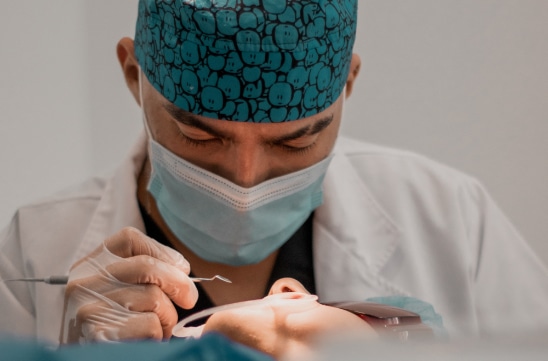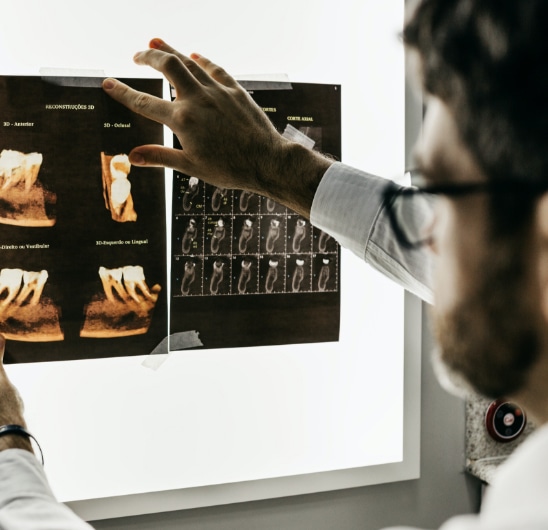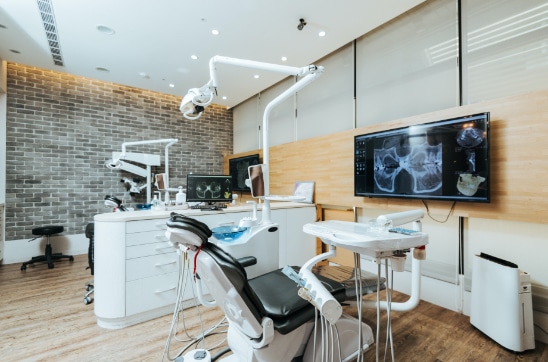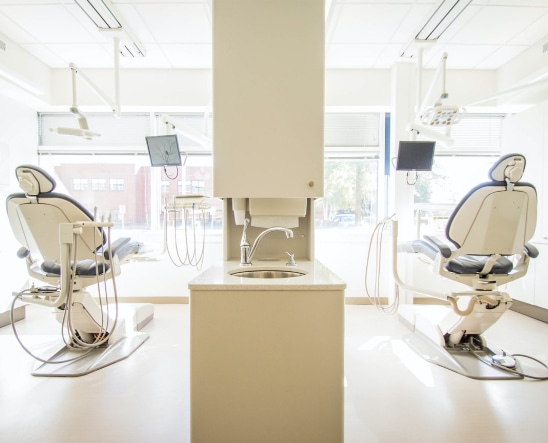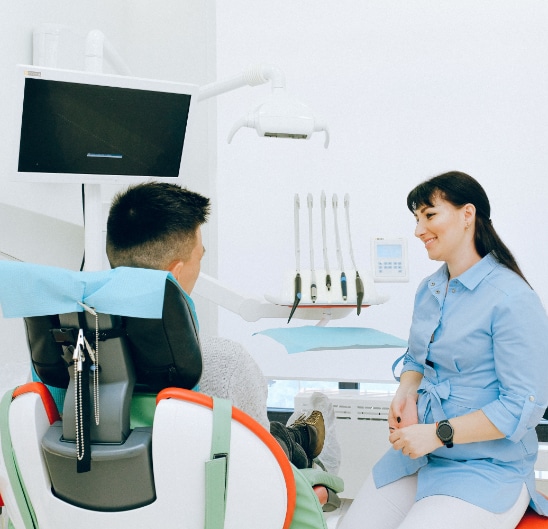
Professional Transition Strategies Success Stories
At Professional Transition Strategies, we are proud of all the doctors and dentists who have found success with their transitions through us. After completing over 550 transactions, we have seen common themes as well as unique cases throughout our history.
From DSO affiliations and partnerships to retirement and family-owned practices, PTS have helped write success stories for nearly every situation and transition. Our innovative team of creative problem-solvers implement data-driven practices to ensure a smoother transition, always with your unique goals in mind.
Dr. Abbott’s Story: Stepping Away from His Practice To Build a Dental School
Dr. Dennis Abbott grew tired of owning his dental practice and when the opportunity to build the Kansas City University’s College of Dental Medicine from the ground up presented itself, he knew it was time to sell his practice. As he begins his journey as the Assistant Director of Biomedical and Clinical Sciences, he looks back on selling with us and his life after transacting.
Allen Dental’s Story: Exploring Unique Retirement Concepts
Springs Dentistry’s Story: Starting a DSO
Texas Dental’s Story: Successful Practice Explores Affiliation Opportunities
The dentists at Texas Dental had been approached by groups over the years interested in their exit strategy. PTS helped guide them through the sale of their large, successful FFS practice by creating a competitive environment and presented the doctors with numerous offers. Learn why they did not accept the highest offer…

Common Transitions & Motivations
STANDARD BUYOUTS FOR AGE
The most common reason for a person to sell their practice is because they believe it is time for them to retire. This was the case for a prosthodontic office near San Diego. He had been working for 30+ years after getting out of the army and had built a good-sized practice over that time. His CFA had been giving him good advice to start thinking about selling his practice so that he and his wife could do the things they had been planning for many years.
His revenue had been flat over the previous few years, but the practice had not started to decline nor had the number of referrals coming into the office. If no pre-planning with associates, partners, or mergers has been done, this is a very good time to be thinking about the sale of a practice. Most formulas for practice valuation take into consideration the top line revenue, bottom line net income, and the assets of the practice. However, those items are weighted against how up to date the practice looks, how much the practice has kept up with technology, and most importantly the number of new patients coming through the door. His practice was in a rented building and had been remodeled 13 years ago. He was digital with his imaging but he did not have many of the imaging and scanning capabilities that are becoming more standardized in prosthodontic offices.
The patients and the staff seemed to be very loyal with the exception that his assistant and front office manager had been employed by him for over 25 years apiece and they had said multiple times that they wanted to retire whenever he was going to. At PTS, we run into similar situations on a weekly basis. Whether a family member works in the office or the relationships are strong with the employees because of the time spent with the doctor they are unsure of how a transition to a new doctor will work and where that leaves them.
Because of getting good advice, he started the appraisal process with us which involves us doing the following:
- Doing an interview with the doctor to understand more about the practice.
- Taking pictures of the office and equipment to make a comprehensive list.
- Requesting practice management reports to understand how the practice operates.
- Requesting financials from the doctor to back up the practice management software.
- Completing a demographic and competitive analysis on the area.
- Using all of these items to complete a prospectus on the practice which gives a value.
Once the valuation was complete, we sat down with the dentist to talk through how we arrived at the price for the practice and to make sure that the proceeds would be sufficient to justify his pending retirement. In most situations, we like to set the practice price at the appraised value that we come up with because it takes into account how much a buyer could get a loan for and puts us in the position of being very confident with the listing price. When the price is set as an asking price, it makes the entire process more challenging and can provide for issues with financing down the road even if there is a willing buyer at a higher price.
The doctor agreed with the prospectus after a couple of minor changes and we moved on to the marketing of the practice. Many times this is a waiting game as we are sending out the prospectus many times and talking with the buyers advisers. All buyers are required to sign a Non-Disclosure Agreement (NDA) to ensure that the practice will be kept secret from the referrals and patients in the area as well.
In this case, he decided to tell his staff that he was considering retirement but that it may take a while for a plan to be reached. So, we did not have a problem showing the practice during operating hours. However, in most situations, showing the practice after hours would be advised so that the staff and patients do not have to worry about someone walking through their office during working hours. It is also easier to get the buying doctors to see the practice after their schedule is done for the day as well.
In this case, we were able to get 2 offers on the practice in 3 months and the practice transition was finalized 60 days after the offer was accepted. It does take a while to go through the due diligence for a buyer, get financing from a bank, and negotiate the Asset Purchase Agreement. The owner decided to stay on with the practice for another 90 days to introduce the patients that were currently under his care, finish cases that he started, and help the marketing of the practice to the referral base.
Thesis: This is a very normal transaction for PTS to complete. It can sometimes go through quickly and sometimes last up to a year but this is a typical timetable on what to expect. In this case, the first accepted offer was the right deal for both parties, but just because and offer is accepted does not mean that the practice will be sold. Also, it is important to get advice from your advisers about the right time to think about the sale of your practice so that it does not start declining.
FAMILY RELATIONSHIPS
A long-standing general dental practice in North Carolina had a history of good growth since it was started over 30 years before by the founder. Over the years, the owner tried multiple associates in the practice without success because of expectations on one side or the other. However, his love of his profession was apparently infectious as both of his sons decided to go to dental school.
In a family-owned business, it becomes tricky to manage the expectations of not just the 2nd generation owners but also of the other children of the owner who will not be involved in the practice. In order for everyone to accept the guidelines of the transition, a fair price should be established to make sure the retirement goals of the owner are achieved while keeping everyone in the family happy with the outcome.
PTS was brought in to help with impending transition while both sons were in dental school. The owner of the practice never really thought his practice would be worth much, but after our independent 3rd party appraisal, the valuation showed a $960K practice purchase price on the open market.
In response to the challenges of bringing on two separate children that are two years apart in school, PTS developed a ROADMAP to practice ownership where the owner could feel good not just about being able to practice with his children but also that he and the rest of the family would be taken care of just as he would have been on an open market sale.
This ROADMAP outlined many items including the following:
- The purchase price of practice
- How the practice would transition to the new owners over the course of 5 years
- Responsibilities on both sides
- Demographic analysis
- Strategic plan for an addition to the practice to accommodate 3 providers
- A growth and marketing plan to ensure the practice was busy and staffed
Results: The owning doctor decided through the analysis that with the growth plan in place, he would be able to offer 33% stakes in the company for each of his sons at no cost to him by using tax free stock gifting to each of his sons over the course of multiple years as a large portion of their inheritance. The additional 33% would be retained by him during the first 5 years and then could be sold on the open market to either an additional dentist or to his sons to satisfy his retirement goals as well as his other heir.
Further, he was able to avoid significant tax bills by structuring the buy-ins in this way. By the time that he was ready to sell the additional 33% of the practice 6 years later, he was able to sell that stake for 685K to another associate as the practice was very busy given the growth plan they had undertaken!
Thesis: While this is an unusual transaction type, at PTS, we leave all options on the table and try to think outside of the box to achieve goals for all parties while looking for win/win/win scenarios. Many multi-generational practices end up opening themselves up for many unforeseen consequences and issues that could have been avoided if a 3rd party would have had a chance to formulate a comprehensive strategy for success.
Complicated Sale
A very established group of Texas Oral Surgeons had just completed an expansion into their third location after they had brought on their seventh clinician. At that point, there were five partners in the practice who owned the practices and real estate with varying loan amounts on each of the locations depending on how long they were in operation and the status of equipment upgrades.
At this point, the two founders of the practice were wanting to sell their portions of the practice to remaining clinicians while making the two associates into partners in the practices. Their original idea was that the real estate would continue to be held by the five partners and that a more formalized lease would occur between the two groups. Also, they had decided that the group would retain the two exiting surgeons as employees of the practice as suitable replacement(s) were found to take over the work which was allocated to sellers.
With the guidance of PTS, the correct solutions were found in each of these categories:
- Valuation: Because of the unique structure and difference in ownership between the clinicians, coming to a practice and real estate value that was acceptable to all of the sellers at different stages in their career, cash flow positive to the buyers, and sustainable in the future when other partners were looking to buy in was a challenge from a valuation and negotiation point of view.
- Contract: A stock sale was decided on in each of the entities to ensure continuity from an insurance and governance point of view.
- Timeframe: Instead of having both sellers on as associates on the backend for at least a year, it was decided the best strategy would be for us to find replacements and the associateship lasting as long as the transition dictated in terms of introducing the new clinicians to the referral base.
- Headhunting: Finding two qualified surgeons who fit well into the culture of the group while at the same time brought on additional specialties that were lacking in the group was an important facet of allowing the selling doctors to leave the practice in good hands. A ROADMAP to ownership was implemented to make sure that the new associates had the best chance of success moving forward.
- Financing: Three separate lenders were used to execute the deal including a practice loan, a SBA loan for the real estate, and an equipment purchase loan to make each of the offices interchangeable from an equipment point of view
- Continuity: While the practice had achieved economies of scale with volume that was being completed, keeping the existing referral base was vital to the success of the new ownership group. Implementing transitionary principles allowed for the constant flow of patients.
- Exit Strategy: Networking with multiple CPAs, CFAs, and attorneys to optimize each of their clients long term goals while understanding the needs of the others in the group was integral to the success of the deal for all parties.
Thesis: At PTS, we are able to take on even the most complicated and multi-faceted sales because we have proved to excel in unique and original circumstances. Most times, the sale is going to be less involved than one like this. But, know that we will use these skills that have been developed in the complicated sales to traditional buy out scenarios.
Timing Is Key
A clinician in Colorado had a very long standing and well respected practice in a medium sized city. He operated a decent sized practice with a good patient following and a very loyal staff. Over the course of a year, he decided that he would be interested in selling his practice. Not because he needed the funds for retirement but so that he would have more to pass to his heirs rather than just closing the business.
Very similarly to most clinicians, he did not think that there was very much value in his practice. However, after and independent 3rd party appraisal by PTS, the valuation showed a $310K practice price. Even though he was surprised by that number, he decided to list the practice and field some offers.
The very first offer that came in was from a local doctor who wanted to expand his current practice and saw the opportunity to expand into another location and increase his brand recognition. The offer price was a full appraised value offer with minimal contingencies and a pre-qualified buyer. Naturally, the offer was accepted by the owner of the practice and the due diligence period began. This is the time where the buyer can look through financials, patient histories, practice management software, and other pertinent documents.
The good news is that nothing changed the buyers opinion of the practice and we proceeded to go to the contract phases where an Asset Purchase Agreement would be constructed with all of the deal points included. Unfortunately, the seller suddenly got cold feet and told us over lunch that he just wouldn’t be able to sell the practice. He wasn’t ready.
While this has happened many times in the past and there are always reasons buyers or sellers could back out of deal, this one is particularly unique because of what happened less than a year later. The seller was driving the same way home from his practice as he had for years and was involved in a terrible wreck. He broke his hip and had to stop practicing immediately with his practice staffed by local friends and colleagues. Furthermore, he was not able to come back and practice dentistry in any capacity.
The good news is that he did not rely on the sale of his practice for his or his families welfare. The issue is that rather than the practice selling for a fair price, it was bought for 17 cents on the dollar.
Thesis: At PTS, we have many stories that are similar to this one with much more dire results. While this is never expected and there is a reason to have multiple types of insurance, this is a reality that should be dealt with in all practices. At some point, there is a good time to sell or transition your practice and knowing when the right time might be should be a joint decision between family, coworkers, and a trusted adviser.
Knowing the difference between a good time, too soon, or too late is an important discussion to have with those groups and can be facilitated by a broker to ensure good decision making strategies.
